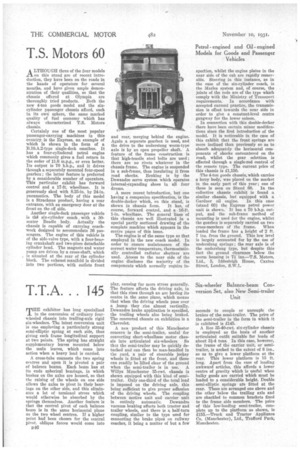T.S. Motors 60
Page 36

If you've noticed an error in this article please click here to report it so we can fix it.
A LTHOUGH three of the four models 2-Lon this stand are of recent introduction, they have been on the roads in the hands of operators for several months, and have given ample demonstration of their qualities, so that the chassis offered at Olympia are
thoroughly tried products. Both the new 4-ton goods model and the sixcylinder passenger chassis afford, each in its own sphere, the same marked quality of fuel economy which has always characterized T.S. Motors chassis.
Certainly one of the most popular passenger-carrying machines in this country. is the Express, on example of which is shown in the form of a B.10.A.2-type single-deck omnibus. It has a four-cylindered petrol engine which commonly gives a fuel return in the order of 11.6 m.p.g., or even better. Its output is 70 blip., and it drives through a separately mounted four-speed gearbox ; the latter feature is preferred by a considerable number of operators. This particular exhibit has forward control and a 17-ft. wheelbase. It is generously shod with 8.2Z-in. by 24-in. Pneumatics. The body of this model is a Strachans product, having a rear entrance, with an emergency door at the front on the off side.
Another single-deck passenger vehicle is tha six-cylinder coach with a 80seater Beadle body. Actually the chassis is capable of carrying coachwork designed to accommodate 36 passengers. The engine of this vehicle is of the side-valve type, with a four-beasins crankshaft and two-piece detachable cylinder head. The magneto and water pump are driven by a cross-shaft, which , is situated at the rear of the cylinder block. The exhaust manifold is divided into two portions, with outlets front and rear, merging behind the engine. Again a separate gearbox is used and the drive to the sinderslung worm-type axle is by an open propeller shaft. A feature of the frame construction is that high-tensile steel bolts are used ; there are no rivets whatever in the chassis frame. The engine is suspended in a sub-frame, thus insulating it from road shocks. Braking is by the Dewandre servo system which operates internal-expanding shoes in all four drums.
A more recent introduction, but one having a companion specification, is the double-decker which, on this stand, is shown in chassis form. It has, of course, forward control, and a 16-ft. 1-in. wheelbase. The general lines of this chassis are well illustrated in a special partly sectioned drawing of the complete machine which appears in the centre pages of this issue.
The engine is of the same type as that employed in the new coach model. In order to ensure maintenance of the correct water temperature, thermostaticallycontrolled radiator shutters are used. Access to the near side of the engine discloses the majority of the components which normally req'uire in
spection, whilst the engine plates in the near side of the cab are rapidly removable. Steering in this instance, as in the ease of the six-cylinder coach, is the Marks system and, of course, the joints of the rods are of the type which comply with the Ministry of Transport requirements. In accordance with accepted current practice, the transmission is offset towards the near side in order to give a constant-level centre gangway for the lower saloon.
In connection with this double-decker there have been certain minor modifications since the first introduction of the model. It is noticeable in the case of this exhibit that the front springs are more inclined than previously so as to absorb adequately the horizontal components of shocks encountered on the road', sirhilst the gear selection is effected through a single-rod control of the remote type. The current price of this chassis is £1,150.
The 4-ton goods chassis, which carries a lorry body, was placed on the market in the early part of this year ; one of these is seen on Stand 60. In the collective chassis exhibit is found a similar chassis, but equipped with a
Gardner oil engine. In this ease (stand 60) the Express petrol power unit is shown. It has a 70 b.h.p. output, and the sub-frame method of mounting is used for the engine, whilst the gearbox is separately carried on two cross-members of the frame. When loaded the frame has a height of 2 ft. 7 ins, from the ground. This low level is largely accounted for by the use of underslung springs ; the rear axle is of the nnderslung type, but despite thia fact the ground clearance below the worm housing is 7-1 ins.—T.S. Motors, Ltd., 5, Iddealeigh House, Caxton Street, London, S.W.1.
















































































































































